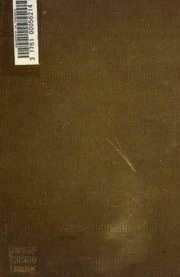
The principles of psychology PDF
Preview The principles of psychology
AMERICAN SCIENCE SERIES ADVANCED COURSE THE PRINCIPLES OF PSYCHOLOGY WILLIAM JAMES PROFESSOR OF PSYCHOLOGY IN HARVARD UNIVERSITY IN TWO VOLUMES VOL. II NEW YORK HENRY HOLT AND COMPANY 1905 Ul V * - Copyright, 1P90 BY HENRY HOLT & CO. HOBERT DRTIMMOND, ELECTROTYPER AND PRINTER, NEW YORE CONTENTS. CHAPTER XVII. .PA1OK SENSATION, . . . . . . . . Its distinction from perception, 1. Itscognitive function acquaintance withqualities, 3. No puresensations after the first days of life, 7. The relativity of knowledge/ 9. The law of contrast, 13. The psychological and the physiological theories ofit, 17. Berings experiments, 20. The eccentric projection ofsensations, 31. CHAPTER XVIII. IMAGINATION, 44 Our images are usually vague, 45. Vague images not neces sarily general notions, 48. Individuals differ in imagination; Gallon s researches, 50, The visile type, 58. The audile type,60. The motile type, 61. Tactileimages. 65. Theneural processof imagination, 68. Itsrelations to that of sensation, 72. CHAPTER XIX. THE PERCEPTION OF (THINGS/ 76 Perception and sensation, 76. Perception is of definite and probable things, 82. Illusions, 85; of the first type, 86; of the second type, 95. The neural process in perception, 103. Apperception, 107. Is perception an unconscious inference? 111. Hallucinations, 114. The neural process in hallucination, 122. Binets theory, 129. Perception-time/ 131. CHAPTER XX. THE PERCEPTION OF SPACE, 134 The feeling of crude extensity, 134. Theperceptionof spatial order, 145. Space- relations, 148. The meaning of localization, 153. Local signs. 155. The construction of real space, 166. The subdivision of the original sense-spaces, 167. The sensation iii iv CONTENTS. PAGS of motion over surfaces, 171. The measurement of the sense- spaces by eachother, 177. Their summation, 181. Feelings of movement in joints, 189. Feelingsofmuscularcontraction, 197. Summary so far, 202. How the blind perceive space, 203. Visual space,211. HelmholtzandReidonthetestofasensation, 216. Thetheoryofidenticalpoints,222. Thetheoryofprojection, 228. Ambiguityofretinalimpressions, 231 ; ofeye-movements, 234. The choice of the visual reality, 237. Sensations which we ignore, 240. Sensations which seem suppressed, 243. Dis cussion of Wundts and Helmholtzs reasons for denying that retinal sensations are of extension, 248. Summary, 268. His torical remarks, 270. CHAPTER XXL THE PERCEPTION OF REALITY, 283 Belief and its opposites, 283. The various orders of reality, 287. Practical realities, 293. The sense of our own bodily existenceisthenucleusofallreality,297. Theparamountreality ofsensations, 299. The influence of emotion and active impulse on belief, 307. Belief in theories, 311. Doubt, 318. Relations ofbelief and will, 320. CHAPTER XXII. REASONING, 323 Recepts, 327. In reasoning, we pick out essentialqualities, 329. What is meant by a mode of conceiving, 332. What is involved in the existence of general propositions, 337. The two factors of reasoning, 340. Sagacity, 343. The part played by association by similarity, 345. The intellectual contrast between brute and man: association bysimilaritythefundamentalhuman distinction, 348. Different orders of humangenius, 360. CHAPTER XXIII. THE PRODUCTION OF MOVEMENT, 373 The diffusive wave, 373. Every sensation produces reflex effects on the whole organism, 374. CHAPTER XXIV. INSTINCT, 383 Itsdefinition, 383 Instincts not always blind or invariable, 389. Two principles of non-uniformity in instincts: 1) Their inhibition by habits, 394; 2) Their transitoriness, 398. Man has
